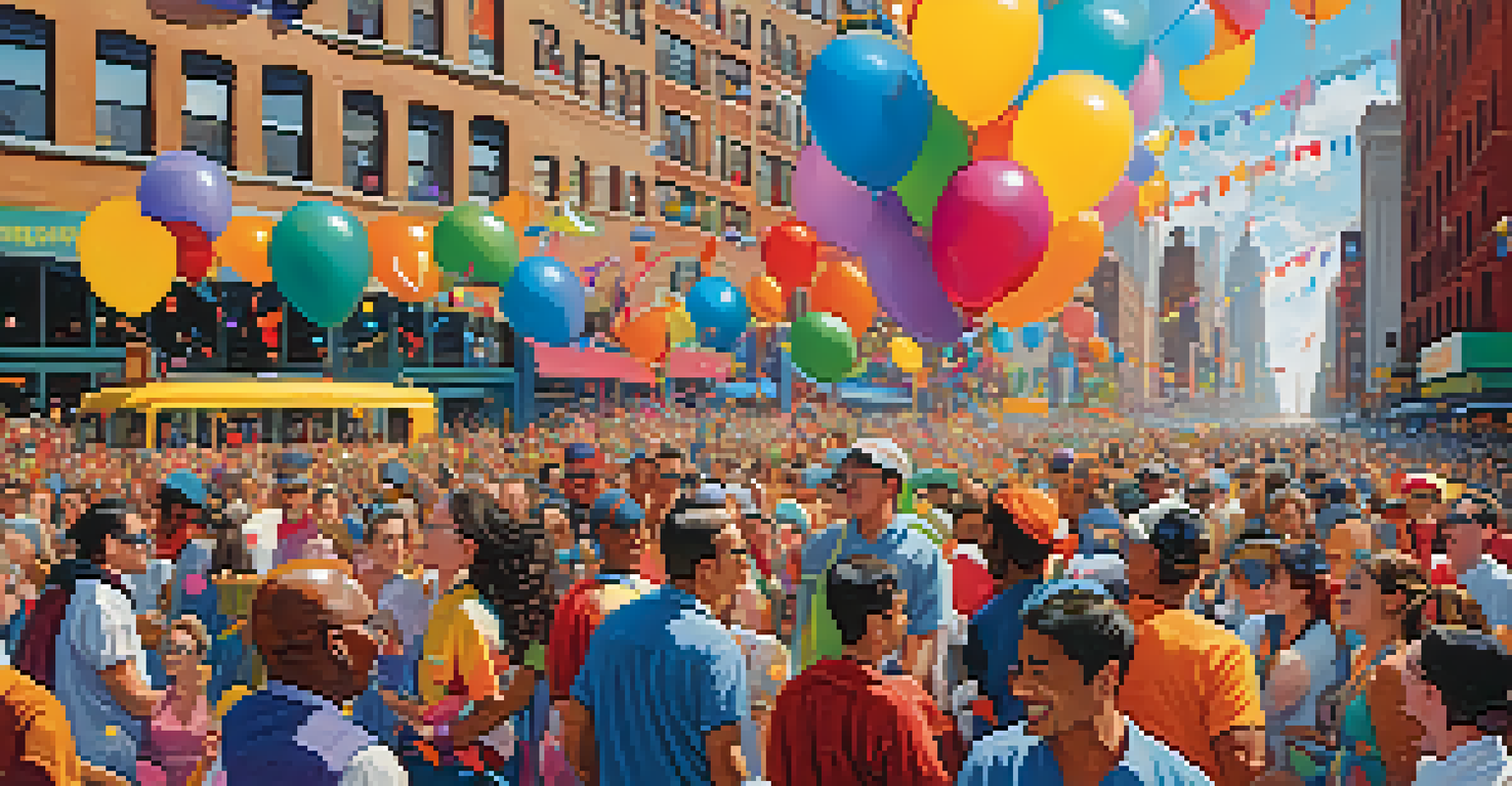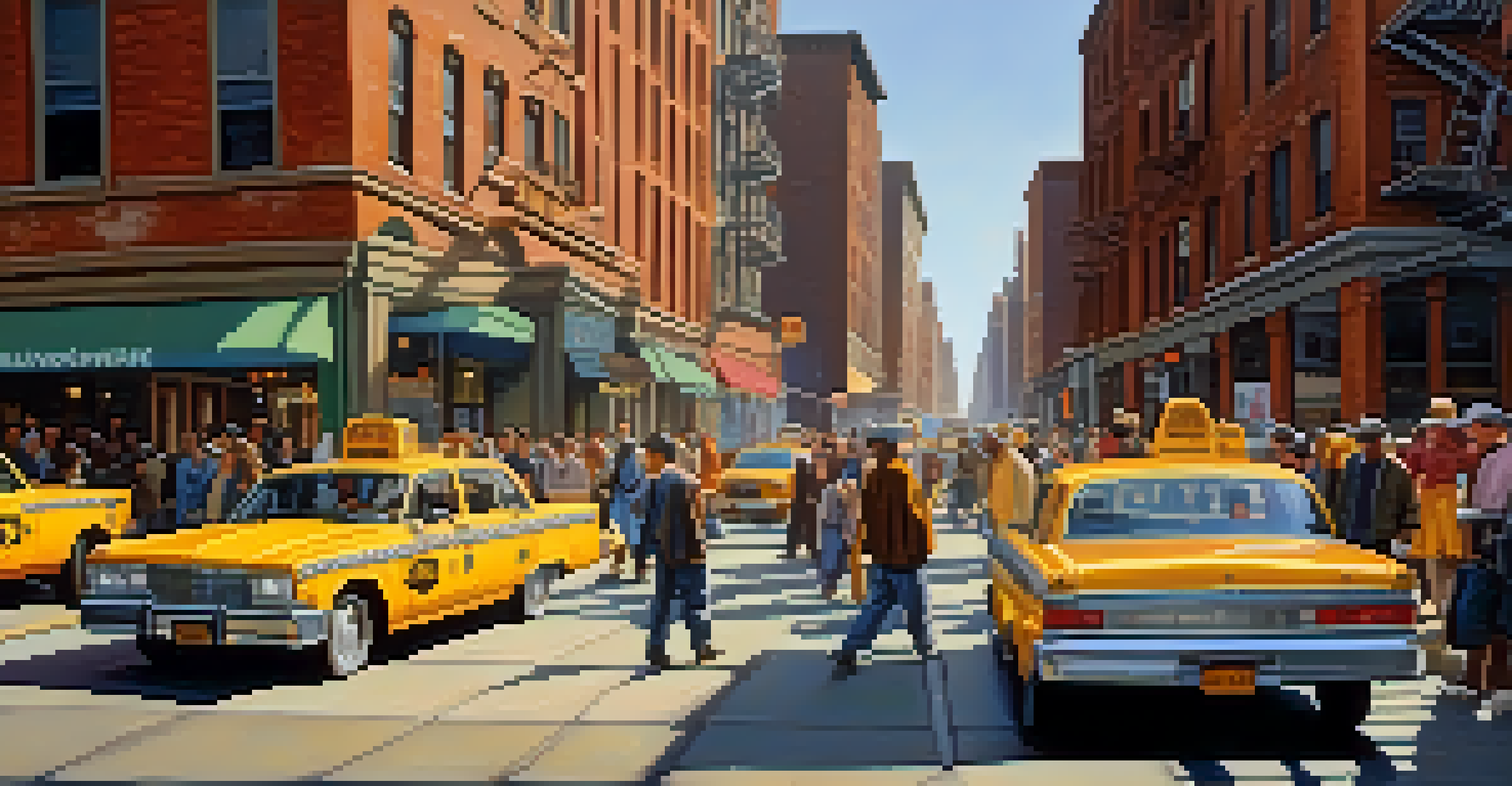Public Perception of Crime Trends in New York City

Historical Context: NYC's Crime Rates Over the Decades
New York City has a rich history with crime rates that have fluctuated dramatically over the decades. In the 1990s, the city was infamous for its high crime rates, with violent crime at an all-time high. However, the early 2000s saw a significant decline, leading to a perception of NYC as a safer place. Understanding this historical context helps frame the current public perception of crime.
The media's focus on crime stories can create a sense of urgency and fear that often doesn't match the actual risk.
The dramatic shifts in crime rates have influenced not just statistics but also the narratives surrounding safety in New York. As crime rates dropped, many New Yorkers began to feel more secure in their neighborhoods, fostering a sense of community. This ongoing ebb and flow of crime rates and perceptions illustrates how interconnected these elements truly are.
Today, discussions around crime often reference these historical trends, with residents recalling the past as a lens through which they view the present. This historical backdrop is crucial for understanding current concerns and fears about crime in the city.
Media Influence: Shaping Crime Perception in NYC
The media plays a pivotal role in shaping public perception of crime trends in New York City. News reports often highlight violent incidents, leading to heightened fears among residents, even if overall crime statistics are declining. Sensationalized coverage can create a narrative that does not accurately reflect the reality of safety in the city.

For example, when a high-profile crime occurs, it tends to dominate headlines, overshadowing the everyday safety that many neighborhoods experience. This can lead to a skewed perception where individuals feel unsafe despite statistical evidence suggesting otherwise. The media's focus on crime stories can create a sense of urgency and fear that often doesn't match the actual risk.
NYC's Crime Rates: A Historical Shift
New York City's crime rates have drastically changed over the decades, with notable declines since the 1990s shaping public perceptions of safety.
It's essential for New Yorkers to critically analyze media reports and seek out comprehensive data on crime trends. By doing so, they can better understand the realities of their environment and make informed decisions about their safety.
Community Perspectives: How Residents View Crime Today
Residents in New York City often have diverse perspectives on crime based on their personal experiences and neighborhoods. Some areas report feeling very safe, while others grapple with concerns about rising petty crimes like shoplifting or vandalism. This variation underscores the importance of understanding the local context when discussing crime trends.
As New York City embraces more technology in law enforcement, perceptions of safety may improve, but concerns about privacy and civil liberties could complicate this narrative.
In many communities, residents actively engage in neighborhood watch programs or local safety initiatives, fostering a sense of empowerment and collective responsibility. These grassroots efforts can significantly impact how safe people feel and how they view crime in their area. A strong sense of community can often mitigate feelings of vulnerability, even in the face of crime reports.
Ultimately, these personal narratives and community responses shape the broader public perception of crime in NYC. It's crucial to listen to these voices to gain a full understanding of how crime affects daily life across the city.
The Role of Technology in Crime Reporting and Perception
Technology has transformed how crime is reported and perceived in New York City. With the rise of social media platforms, incidents can be shared in real-time, often leading to immediate reactions and heightened fears. This instantaneous reporting can create a sense of urgency that may not accurately reflect the broader crime trends.
Apps and websites that track crime data allow residents to stay informed about incidents in their neighborhoods. While this can empower individuals, it can also lead to anxiety, as people may focus more on specific crime reports rather than the overall decline in crime rates. Technology, therefore, has a dual impact, fostering both awareness and fear.
Media's Role in Crime Perception
Sensationalized media coverage of crime can distort public perception, often leading to heightened fears that don't align with statistical realities.
As New Yorkers navigate this digital landscape, it's important to balance the information they consume with an understanding of the larger context. Critical engagement with technology can lead to a more nuanced view of crime trends and help mitigate undue fear.
Government Policies: Impacting Crime Rates and Perception
Government policies play a significant role in shaping both crime rates and public perception in New York City. Initiatives aimed at community policing, crime prevention, and social services have contributed to the city’s declining crime rates over the years. When residents see tangible efforts to address crime, it can bolster their sense of safety and trust in local authorities.
However, policies can also lead to mixed feelings among residents, particularly when it comes to issues like stop-and-frisk or other controversial practices. These policies can lead to distrust and fear in certain communities, affecting how residents perceive crime and their safety. The relationship between government action and public sentiment is complex and often fraught with tension.
Understanding how these policies shape perceptions can help residents engage more effectively with local government and advocate for changes that promote safety without compromising community trust.
Public Events: Their Role in Crime Perception
Public events, such as parades, festivals, or protests, can significantly influence crime perception in New York City. While these events often bring communities together and promote a sense of unity, they can also lead to heightened security measures and fears of potential crime. The presence of law enforcement during these events can create a paradox where residents feel both safe and uneasy.
For instance, a large event might attract attention to a neighborhood, leading to concerns about overcrowding and crime. However, these gatherings can also foster a sense of community pride and engagement, reshaping perceptions of safety. The duality of public events illustrates how context can shift the narrative around crime.
Community Engagement Shapes Safety Views
Residents' perspectives on crime vary widely based on personal experiences and community initiatives, highlighting the importance of local context in safety discussions.
Ultimately, public events have the power to enhance community cohesion while simultaneously presenting challenges for crime perception. Balancing these factors is essential for fostering a safe and inclusive environment.
Future Trends: Anticipating Changes in Crime Perception
As New York City continues to evolve, so too will public perceptions of crime. Factors such as economic conditions, social movements, and advancements in technology will play crucial roles in shaping future trends. It's important for residents and policymakers to remain adaptable and responsive to these changes to create a safer environment.
For instance, as the city embraces more technology in law enforcement, such as surveillance and data analysis, perceptions of safety may improve. However, concerns about privacy and civil liberties could complicate this narrative, creating a need for ongoing dialogue among stakeholders. The balance between safety and individual rights will be a hot topic in the years to come.

Looking ahead, fostering a culture of open communication and community engagement will be vital for addressing fears and misconceptions about crime. By anticipating these changes, New Yorkers can prepare for a future that promotes safety while respecting the diverse perspectives within their communities.